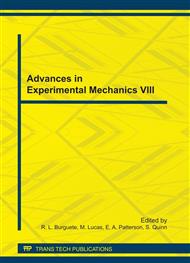[1]
S. Tsopanos, R.A.W. Mines , S.T. McKown,Y. Shen, W.J. Cantwell, W. Brooks, C.J. Sutcliffe, The influence of processing parameters on the mechanical properties of selectively laser melted stainless steel micro-lattice structures, Journal of Manufacturing Science and Engineering, ASME, vol. 132, pp.041011-1 to 12, (2010).
DOI: 10.1115/1.4001743
Google Scholar
[2]
I. Yadroitsev, Selective Laser Melting, Lambert Academic Publishing, (2009).
Google Scholar
[3]
I. Gibson, D.W. Rosen, B. Stucker, Additive Manufacturing Technologies, Springer, (2010).
Google Scholar
[4]
D.W. Thompson, On Growth and Form, Cambridge University Press, (1961).
Google Scholar
[5]
K. Ushijima, W.J. Cantwell, R.A.W. Mines, S. Tsopanos, M. Smith, An investigation into the compression properties of stainless steel micro lattice structures, Journal of Sandwich Structures and Materials, DOI: 10. 1177/1099636210380997, (2011).
DOI: 10.1177/1099636210380997
Google Scholar
[6]
R.A.W. Mines, On the characterisation of cellular materials used in sandwich construction, Strain, Vol. 44 No 1, pp.71-84 , (2008).
Google Scholar
[7]
R.A.W. Mines, Y. Girard, V. Fascio, On the development of conventional and micro lattice cellular metals as core materials in aerospace sandwich construction, SAMPE Europe Conference & Exhibition Paris, 248-255, (2009).
Google Scholar
[8]
R. Hasan, R.A.W. Mines, Y. Shen, S Tsopanos, W.J. Cantwell, W. Brooks, C.J. Sutcliffe, Comparison of the drop weight impact performance of sandwich panels with aluminium honeycomb and titanium alloy micro lattice cores, Applied Mechanics and Materials, Vols. 24-25, p.413 – 418 (2010).
DOI: 10.4028/www.scientific.net/amm.24-25.413
Google Scholar
[9]
Gurit GmbH , EP121-C15-53 Data Sheet, Gurit GmbH, Kassel, Switzerland, (2008).
Google Scholar
[10]
LS-Dyna User's Manual. Version 970. Livermore Software Technology Corporation. Livermore, (April 2003).
Google Scholar
[11]
Y. Shen, S.T. McKown, S. Tsopanos, C.J. Sutcliffe, R.A.W. Mines, W.J. Cantwell, The mechanical properties of sandwich structures based on metal lattice architectures, Journal of Sandwich Structures and Materials, Vol. 12 , pp.159-180 , ( 2009).
DOI: 10.1177/1099636209104536
Google Scholar
[12]
S.T. McKown, The Progressive Collapse of Novel Aluminium Foam Structures, PhD Thesis, University of Liverpool, (2004).
Google Scholar


